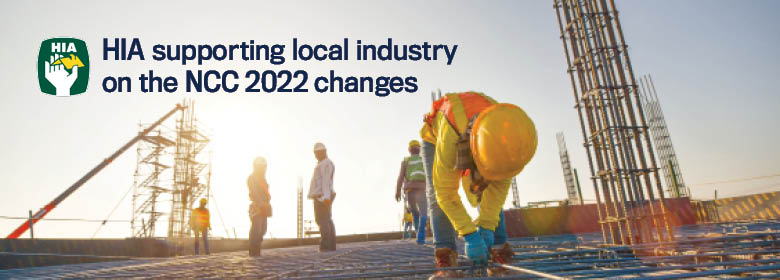HIA Supporting Local Industry on the NCC 2022 Changes
NCC 2022 introduces substantial changes that will impact the way you design and build homes for your clients. To ensure industry has adequate time to incorporate these changes, HIA has been working with industry and the State Government to secure appropriate and lengthy transition periods for the adoption of the Code.
The updated construction code will affect the design and construction of most houses and apartments.
The most significant changes for the housing sector
Livable (accessible) Housing
These provisions will apply to all houses (Class 1a) and apartments (Class 2 buildings) and have been included in both Volumes One and Two. A new referenced ABCB Livable Housing Standard has been included in the NCC 2022.
These will require:
- A step free path of travel from the boundary to the front or entrance door, which can incorporate either an access path or ramps.
- A step free level entrance into the dwelling.
- A minimum of 820 mm clear width of opening for the entrance door and other doors on the entrance level.
- Minimum clear width of 1000mm to corridors connecting doorways that require the minimum clear width opening.
- A toilet on the ground or entrance level with minimum width between opposing walls and 1.2m clear space in front of the pan.
- One shower in the dwelling that is step free and hobless.
- Reinforcing to the framing in the toilet, shower and bath, to enable future installation of grab rails.
Understanding and applying the provisions is critical as their application will require you to consider landscaping for paths and some additional internal room dimensions and building layouts.
Energy Efficiency
Until the final version of the energy efficiency provision are released on 1 October 2022 it is expected they will contain the following:
- Increasing building thermal fabric stringency from 6 to 7 star minimum for houses and apartments (apartments 7-star average and no single apartment less than 6 star)
- New energy usage budget provisions that apply a ‘whole of home’ approach for calculating the energy usage for the following fixed building services (where included) for heating and cooling, hot water, lighting and swimming pool and spa plant.
Condensation
The amendments to the condensation provision are likely to include:
- More stringent building wall wrap permeability requirements, for climate zones 4-8 and specifically for climate zones 6, 7 and 8
- Mandatory external ducting and roof space ventilation requirements; and
- Prescribed flow rates for exhaust fans, rangehoods and provisions for make up air in laundries and run off timers for bathroom exhausts.
Adoption of NCC 2022
The Building Ministers met on 26 August to sign off on the energy efficiency and condensation provisions and the adoption dates for the introduction of NCC 2022 and the Livable Housing Standard.
The Building Ministers have agreed to the adoption of the majority of NCC 2022 on 1 May 2023 and the adoption of the energy efficiency and condensation provisions and livable housing on 1 October 2023.
The final completed version of NCC 2022 will be available from the ABCB website from 1 October 2022.
NSW
NSW will not be adopting the livable housing provisions, however, BAISX will continue to replace NCC energy requirements, and include an increased stringency to 7-stars to align with NCC, and further increased stringency for energy and heating/cooling loads. A combined heating+cooling load cap is being introduced.
Victoria
Victoria will be adopting both the livable housing standard and 7-star energy efficiency for the building fabric with a Whole of Home energy usage requirement provisions from 1 October 2023. HIA is actively seeking the Victorian Government’s confirmation of their intended time frame.
What has HIA been doing in response to the changes?
HIA has met with the Ministers and heads of government departments and made several substantial submissions on these proposed changes.
HIA has also worked to actively engage members about the proposed changes. HIA has put forward detailed members concerns and backed this up with our engagement with governments to ensure our industry’s views and voice has been heard.
HIA called for a full three-year transition or at a very minimum of 18 months. The Building Ministers decision is disappointing from an industry perspective as more time to is needed to adapt to the significant changes this imposes.
Want to know more about the changes?
HIA is running face-to-face seminars in September to provide a detailed breakdown of the proposed changes. Visit www.hia.com.au/national-constructioncode.
Read a preview of the second stage NCC 2022, including energy efficiency and condensation changes https://abcb.gov.au/news/2022/stage-2-ncc-2022-out-now.
Fiona Nield
HIA Executive Director, Victoria
A town planner, regulatory and policy specialist, Fiona has extensive experience in planning, land development, building policy and housing matters. Her career in planning, building and housing policy has evolved over 25 years and Fiona’s current as the HIA Executive Director, Victoria, includes regularly dealing with a wide range of urban planning, development industry, home builders, building professionals and government stakeholders – and to help to solve complex building and planning matters while improving the planning and building systems. Her knowledge of strategic and statutory planning reform matters extends beyond Victoria and nationally, including housing taxation and development contribution matters, both infill and greenfield land use issues. Fiona also has extensive experience with regulatory matters, having also worked in state and local government.



